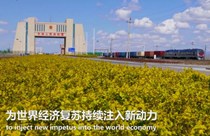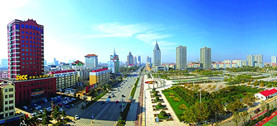A Re-estimation of Urban-Rural Employment and Urbanization Ratio
Author : Source : Chinese Social Science Digest 2014-05-28
Inconsistencies with statistics on China’s urban and rural populations and employment have made it difficult to accurately judge the present development of urbanization or predict its future development to make sound policy choices. This article aims to provide a re-estimation of China’s urban and rural populations and employment, as well as examine the actual urbanization level for the purpose of identifying future trends and problems that need addressing.
Statistics on China’s population and employment are mainly based on national census data. There is smooth movement from the non-census data between every two censuses to the census data, which shows the national census every decade is a basic reference for annual statistics on population and employment. Non-census data is calculated based on data of smaller population surveys, but it uses previous census data as its framework. Therefore, the accuracy of census data determines the accuracy of population and employment data in previous years. It is the key to making an informed judgment of China’s urbanization situation.
The main problem with census data is that the floating population, especially migrant workers who represent the key demographic in urbanization, is easily excluded. We mainly examined and calculated the data of urban and rural floating populations in the 2010 census. The “floating populations” here refer to people who are away from their registered residence for more than six months. Their residence while employed differs from their registered residence. Such people constitute part of the permanent population in cities of their employment.
According to the 2010 census, there is a floating population of 260.94 million people nationwide, 225.96 million of whom live in cities. There are 137.57 million people originally from rural areas, who account for 60.9 percent of the floating population in cities. They comprise of migrant workers, some of their non-working family members and rural residents who have migrated to urban areas for reasons other than employment.
Based on calculations of urban resident populations, the total number of migrant workers in urban areas is 87.72 million, accounting for 63.8 percent of the rural-urban floating population. Among these 87.72 million migrant workers, more than 62 million live in cities and 25.58 million live in towns. In addition, there are 17.07 million migrant workers moving to other rural areas away from their hometowns. This brings the total number of migrant workers nationwide to 104.79 million.
Monitoring data of migrant workers indicates that in 2010 there were 153.35 million migrant workers nationwide, 46.34 percent more than the 104.79 million migrant workers reported in the census. The number of migrant workers among urban resident populations should therefore be adjusted from 87.72 million to 128.37 million, an increase of 40.65 million. This refers to the number of migrant workers working in urban areas who were excluded by the census. Because 40.65 million migrant workers were uncounted in 2010 statistics of nationwide urban employment, the number of urban workers should be adjusted from 346.87 million to 387.52 million, up 11.72 percent.
With a fixed number of nationwide employees, the number of urban workers left out is an overstated number of their rural counterparts. From 2000 to 2010, statistics for nationwide employment left out 10.10 million new workers, which means the number of nationwide workers in 2010 needs to be adjusted from 761.05 million to 771.15 million. Therefore, the overstated number of rural workers in 2010 is 30.55 million, and the number of rural workers should be adjusted from 414.18 million to 383.63 million, down 7.38 percent.
With masses from the rural labor force migrating to cities, urban employment figures are larger than those reflected in statistics. They have grown faster, while rural employment figures are smaller than those reflected in statistics and have likewise declined faster. In 2010, urban employment surpassed rural employment. The number of urban workers in 2012 should be adjusted from 371.02 million to 418.21 million, up 47.19 million. The comparative number of rural workers should be adjusted from 396.02 million to 364.43 million, down 31.59 million. In 2012, the national proportion of rural workers dropped from 51.6 percent to 46.6 percent, down 5 percent.
The exclusion of floating migrant workers from the census influences not only urban and rural employment figures, but also statistics on urban and rural populations. We have made adjustments to numbers for the urban and rural populations based on understated figures for urban employment and overstated figures for rural employment. According to the adjusted data, China’s urbanization ratio exceeded 50 percent in 2009, two years earlier than it was actually reported. In 2012, the permanent urban population increased to 759 million, while the permanent rural population fell to 611 million. China’s urbanization ratio therefore reached 55.4 percent in 2012.
The growth rate of China’s employment in recent years is still slightly higher than that of the population. The employment-to-population ratio in urban and rural areas has been reasonable in light of this trend. In 2012, the employment-to-population ratio in urban and rural areas was 52.1 percent and 61.7 percent respectively, up by an average of 9.6 percent. However, the adjusted employment-to-population ratio for the same year in urban and rural areas was 55.1 percent and 59.7 percent respectively, up a modest 4.6 percent.
A forementioned adjusted statistics on urban and rural employment and population indicate that the rural labor surplus is lower than current statistics suggest. The potential of the rural labor force transferring to towns is also accordingly reduced. So, how does this affect future development of urbanization and labor resources? We may discuss as follows.
Firstly, amended data still does not support the conclusion that the transfer of China’s rural labor surplus has been completed or even nearly completed. The surplus of 364 million rural workers is still enormous on a national scale given the country’s arable land. Calculations based on the agricultural (primary industry) labor force accounting for 65.7 percent of the rural labor force in the statistics show that in 2012 the number of nationwide agricultural workers was 239.43 million, with each worker having an average of 0.51 hectares of arable land. The scale of average arable land for each worker is less than one-tenth of that in some developed countries. Based on conservative estimates, it is still reasonable and feasible that at least a half or two-thirds of the current rural labor force will be urbanized. Therefore, the transfer of the rural labor surplus is still far from complete.
Secondly, it should be noted that there is a huge difference in the age ranges of rural and migrant workers. People aged 16 to 45 only account for 42 percent of the rural population. This must be taken into consideration when estimating the rural labor force. Nevertheless, this does not alter the conclusion that the transfer of the rural labor surplus is far from complete.
Thirdly, despite the imposing size of China’s rural labor force, shortages of migrant workers in some areas over recent years signal an early emergence of the Lewis Turning Point, a theory by economist Arthur Lewis that refers to the point when a country’s excess labor is fully absorbed and further capital accumulation results in a subsequent increase in wages. This has been mainly brought about by problems experienced by the rural population amid urbanization.
Under the current hukou (household registration) system, even if rural residents work in cities over a long term, they cannot easily obtain a hukou in their city of residence. Currently, 42 percent of the more than 700 million permanent urban residents lack a hukou for the city of their residence. They cannot access welfare or social security benefits without a local hukou.
For the above reason, most migrant workers cannot settle down in the cities where they work. Many have to return to their hometowns with modest savings upon reaching middle age, or settle down in small towns nearby their hometowns. However, in the countryside and small towns they usually have limited employment opportunities.
In the future, if we effectively advance reform of the hukou system and constantly improve the social security and public welfare systems to make it easier for migrant workers to settle down in urban areas, the transfer of rural populations to cities will be prolonged and unlock huge potential in labor resources.
Between 2008 and 2012, adjusted figures for China’s urban resident and urban worker populations increased by an annual average of 24 million and 15 million respectively. Urban population growth has mainly resulted from rural workers moving to cities and farmland being urbanized. It is estimated that the urbanization ratio will grow by 10 percent over the next decade, possibly exceeding 65 percent by 2022. However, the transfer of the labor force may slow down in the future due to slow economic growth. Meanwhile, reform of the hukou and social security systems is likely to accelerate the progress of citizenization of migrant workers.
.
Wang Xiaolu is the deputy director of the National Economic Research Institute at the China Reform Foundation. Wan Guanghua is the founding director of the Research Institute for Indian Ocean Economies at Yunnan University of Finance and Economics.
Translated by Yu Hui
Revised by Tom Fearon
Ye Shengtao made Chinese fairy tales from a wilderness
Ye Shengtao (1894–1988) created the first collection of fairy tales in the history of Chinese children’s literature...
-
How northern ethnicities integrated into Chinese nation
2023-09-18
-
Mogao caves
2023-09-12
-
Mogao Grottoes as ‘a place of pilgrimage’
2023-09-12
-
Time-honored architectural traditions in China
2023-08-29
-
Disentangling the civilizational evolution of China
2023-08-28
-
AI ethics in science fiction
2023-08-23














 2011-2013 by www.cssn.cn. All Rights Reserved
2011-2013 by www.cssn.cn. All Rights Reserved